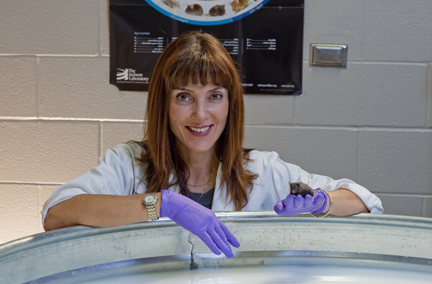 After the 40th birthday it becomes necessary to write notes — and then try to remember the location of the notepad. Learning and memory decline with age, and for some the cliff is Alzheimer’s disease. Thankfully, scientists from the Sam and Ann Barshop Institute for Longevity and Aging Studies at the UT Health Science Center at San Antonio are studying a compound that could rescue our flagging memories.
After the 40th birthday it becomes necessary to write notes — and then try to remember the location of the notepad. Learning and memory decline with age, and for some the cliff is Alzheimer’s disease. Thankfully, scientists from the Sam and Ann Barshop Institute for Longevity and Aging Studies at the UT Health Science Center at San Antonio are studying a compound that could rescue our flagging memories.
The researchers added a bacterial product — rapamycin — to the diet of healthy mice throughout their life span. Rapamycin, first isolated from soil on Easter Island, enhanced learning and memory in young mice and improved these faculties in old mice, studies showed.

“We made the young ones learn, and remember what they learned, better than what is normal,” said the Barshop Institute’s Veronica Galvan, Ph.D., assistant professor of physiology in the Long School of Medicine. “Among the older mice, the ones fed with a diet including rapamycin had an improvement, negating the normal decline you see in these functions with age.”
The drug also lowered anxiety and depression-like behavior in the mice; anxiety and depression are factors that impair human cognitive performance. Jonathan Halloran of the Galvan laboratory conducted scientifically reliable tests to measure these cognitive components in the rodents.
Mice are burrowers and are happy in a tunnel with walls. Halloran used an elevated maze of tunnels leading to a catwalk without walls. “All of a sudden the mice are in open space,” Halloran said. “It’s pretty far from the floor for their size, sort of like if you’re hiking and all of a sudden the trail gets steep. It’s pretty far down and not so comfortable.”
Mice with less anxiety are more curious to explore the catwalk. “We observed that the mice fed with a diet containing rapamycin spent significantly more time out in the open arms of the catwalk than the animals fed with a regular diet,” Halloran said.
The second test measured depression-like behavior in the rodents. Mice do not like to be held by their tails, which is the way they are moved from cage to cage. Inevitably they struggle to find a way out. “How much and how often they struggle is a measure of the motivation they have to get out of an uncomfortable situation,” Dr. Galvan said.
Some mice barely struggle to get free, but if an antidepressant is administered they struggle a lot more. “We found rapamycin acts like an antidepressant — it increases the time the mice are trying to get out of the situation,” Dr. Galvan said. Anxiety and depression-like behavior decreased in all ages of mice fed with the rapamycin-enhanced diet.
The researchers measured levels of three “happy, feel-good” neurotransmitters: serotonin, dopamine and norepinephrine. All were significantly augmented in the midbrains of mice treated with rapamycin. “This is super-interesting, something we are going to pursue in the lab,” Dr. Galvan said.
Rapamycin rescued learning and memory in mice affected by Alzheimer’s-like deficits, the team previously reported. In the new studies, the enhancements are demonstrated even in healthy mice. The elevation of the three neurotransmitters, which are chemical messengers in the brain, may explain how rapamycin accomplished this, Dr. Galvan said.
Rapamycin is an antifungal agent administered to transplant patients to prevent organ rejection. The drug is named for Rapa Nui, the Polynesian title for Easter Island. This island, 2,000 miles from any population centers, is the famed site of nearly 900 monolithic statues (pictured above). If rapamycin proves to be a suitable therapy for human cognition, this mysterious atoll could be called the Easter Island of learning and memory.
[pexyoutube pex_attr_src=”https://www.youtube.com/watch?v=ja-3UAAoAUc”][/pexyoutube]
